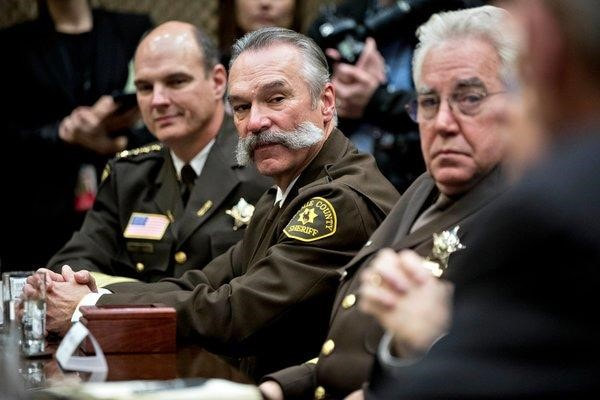Mental Illness, Untreated Behind Bars
 From left, Sheriff Richard Stanek, of Hennepin County, Minn., Sheriff Danny Glick, of Laramie County, Wyo., and Sheriff John Layton, of Marion County, Ind., at a meeting with President Trump at the White House.
From left, Sheriff Richard Stanek, of Hennepin County, Minn., Sheriff Danny Glick, of Laramie County, Wyo., and Sheriff John Layton, of Marion County, Ind., at a meeting with President Trump at the White House.
President Trump has talked quite a bit about cracking down on a nonexistent crime wave. Rarely does he talk about the different kinds of support law enforcement needs or what actually keeps communities safe.
So it might have come as a surprise to him when a member of the National Sheriffs’ Association at a White House meeting earlier this month brought up an urgent problem sheriffs’ offices all face — the mental health crisis that has filled jails to bursting with mentally ill people who would be more effectively dealt with through treatment.
Mr. Trump acknowledged that “prison should not be a substitute for treatment” and said his administration would try to address this challenge. A good start would be to extend the public health system into jails and prisons, which take in the poorest and most illness-prone people in society.
Mental health problems are rampant in local jails, often because the illness was a primary factor in the offensive conduct. The cost of caring for and supervising mentally ill inmates makes them two to three times more expensive to house. Once released, they often stop taking their medications, which lands them in trouble with the law and back behind bars.
Sheriff John Layton of Marion County, Ind., who raised this problem at the White House meeting, noted that often mentally ill people are jailed, not because they pose a threat to public safety, but because their behaviors are annoying to officers and the public. Of the 2,300 inmates in his county, an estimated 40 percent suffer from mental illness. The jail distributes 700 prescriptions a day and spends nearly $8 million a year on care for the mentally ill.
County governments all across the country are struggling to break this cycle. Nationally, more than 325 counties have signed on to the Stepping Up initiative — sponsored by the Council of State Governments Justice Center, the National Association of Counties and the American Psychiatric Association Foundation — which helps local agencies develop methods for diverting mentally ill people who present no public safety risk into treatment.
Last year, Congress passed the Comprehensive Justice and Mental Health Act, which reauthorizes millions of dollars for state and local efforts to reduce the number of imprisoned mentally ill people. It also passed the Mental Health and Safe Communities Act, which supports training that will prepare police officers to recognize signs of untreated mental illness and expands treatment for those returning to society from prison and jail. Congress must now fully fund these programs.
Some states are working to break the recidivism cycle by making sure that inmates are signed up for Medicaid when they are released, so that they can have access to proper medication and care. While that’s important, it’s even more critical that the federal government do away with rules that prevent inmates from receiving Medicaid assistance.
The rules, based on the punitive idea that people who break the law do not deserve public help, essentially cut inmates off from the public health system while forcing cash-strapped corrections systems to pick up the cost of psychiatric care. Denying inmates that care is both inhumane and more costly to taxpayers in the long run.

